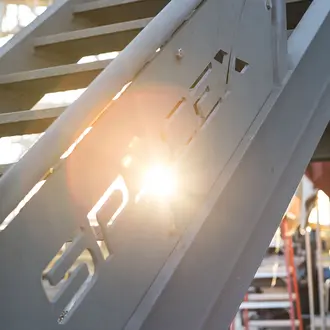Porsche, the iconic German automobile manufacturer known for its high-performance sports cars, has a rich history that dates back to 1931 having been started originally as an engineering office. Almost 50 years ago, the company’s Porsche 928 revolutionized suspension technology—with the legendary Weissach axle. Today, at Porsche's axle manufacturing facility in Stuttgart, Germany, the company is still striving to innovate and improve. This past spring, a team of MIT Sloan Operations Lab (Ops-Lab) students helped them do just that.
The Stuttgart facility features two manufacturing lines that are among the most technologically advanced in the factory, featuring numerous fully automated stations with the ability to produce over 90 different wheel carrier configurations. While the process is mostly automated, several stations involve manual interventions. These two lines experience regular downtime due to unanticipated faults and disturbances. In fact, maintenance technicians report that a significant part of their time is spent performing unplanned or reactive repairs. This level of reactive maintenance not only strains workforce resources but also limits the facility's ability to meet production targets efficiently.
An MIT-KIT project
To generate actionable insights from Porsche’s production lines, the MIT Sloan Action Learning team—Leaders for Global Operations student Jeremy Rosenblatt, LGO ’26 and Na Chen, MBA ’26—dove into a vast and underutilized trove of fault data. In collaboration with colleagues from the wbk Institute of Production Science at the Karlsruhe Institute of Technology (KIT), they analyzed over 250,000 machine-level fault messages collected over two years across 24 workstations. Their objective was to transform this raw automation data into practical recommendations that could support root cause analysis and predictive maintenance.
With no prior experience in the automotive industry—and working entirely with data in German, a language he didn’t speak—MIT student Jeremy Rosenblatt says the learning curve was steep but rewarding.
As an LGO student, Rosenblatt is in both the MBA and Chemical Engineering programs. For him, a personal highlight of the project was visiting the Stuttgart factory in person during the Sloan Intensive Period (SIP) week.
“Seeing the iconic [Porsche] 911 come together in person—it was a once-in-a-lifetime experience,” he says.
For MIT Sloan MBA student Na Chen, visiting Porsche's Stuttgart plant was also a highlight, as it gave her a new perspective on how strategy connects with execution.
“I saw how leadership's goals translated into daily production targets, with every action on the floor tracked and reported up the chain,” she says. “But I also realized that data alone isn’t enough. Leaders need systems that preserve context to stay truly aligned with what’s happening on the ground. What struck me even more, was watching individual parts transform into a branded Porsche that people around the world aspire to own."
Dawn Fitzgerald, MIT Ops-Lab course mentor for the Porsche team, highlighted the distinctive strength of the cross-school project format, “The MIT–KIT Ops-Lab team demonstrated the true power of Action Learning—bringing together diverse disciplines, cultures, and problem-solving approaches to deliver insights that were enhanced by this global Action Learning project.”
Empowering Porsche
The MIT-KIT team—including KIT Professor of Production Technology Gisela Lanza, KIT PhD Candidate Yannik Hermann, and KIT students Aaron Elsing, and Jahn Feng—aimed to empower Porsche with a data-driven framework that would not only support short-term maintenance time reduction, but would also lay the groundwork for a broader predictive maintenance system that is proactive, intelligent, and sustainable. According to Hermann, they accomplished their goals.
Based on the results of the MIT/KIT project team, Porsche was able to identify initial patterns for improving predictive maintenance on the line in question and are using these for further investigations. They plan to conduct further investigations based on these results. And I can confirm that we would be very pleased to see the work between MIT and KIT continue.



